A "Quick & Dirty" Guide to
Recent Shark Teeth
Sixgill Shark Hexanchus griseus
Among the most fascinating of modern shark teeth; all hexanchiform sharks show pronounced sexual dimorphism in the anterior lower teeth, with mature males having an initial cusp much higher than subsequent ones. |
Sandtiger Shark Carcharias taurus
Specimens from southeastern Australia have consistently stouter dentition, leading to speculation that the Aussie Grey Nurse Shark is a distinct species or sub-species. |
White Shark Carcharodon carcharias
The most famous of all shark teeth, those from a large White Shark can command significant prices — a fact which renders this relatively uncommon species a target for trophy hunters. |
Shortfin Mako Isurus oxyrinchus
Teeth of this species were once used as currency by New Zealand Moaris; the Shortfin Mao is considered the premiere gamefish among sharks. |
Tiger Sharks Galeocerdo cuvier
One of the most beautifully-shaped of shark teeth; combines powerful puncturing capability (afforded by the deep primary notch) and efficient ripping (afforded by the large serrae on inner shoulder) — "can opener" dentition is ideally suited to tearing through the tough carapace of sea turtles. |
Bull Shark Carcharhinus leucas
The teeth of various species of whaler (grey) sharks can be very difficult to distinguish; it is probably best to regard all identifications as highly provisional. |
Lemon Shark Negaprion brevirostris
Fossil teeth of this species are remarkably similar to the teeth from modern specimens. |
Great Hammerhead Shark Sphyna mokarran
The teeth of various species of hammerheads can be very difficult to distinguish; it is probably best to regard all identifications as highly provisional. |
 lower anterior teeth comb-like, each with an elongated base and
multiple cusps
lower anterior teeth comb-like, each with an elongated base and
multiple cusps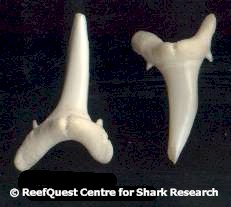 long, slender, smooth-edged blade
long, slender, smooth-edged blade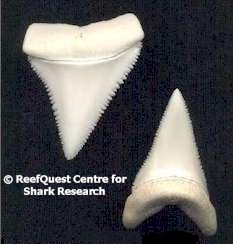 broadly triangular, flattened, coarsely serrated blades
broadly triangular, flattened, coarsely serrated blades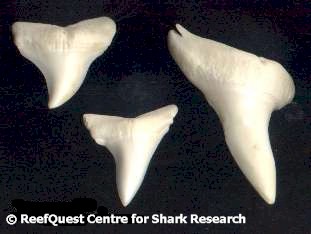 anterior upper teeth slender, knife-like and unsaerrated
anterior upper teeth slender, knife-like and unsaerrated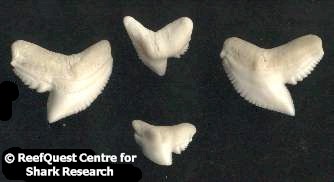 deeply-notched, flattened blade with strong serrations at
shoulders of blade, especially on inner margin
deeply-notched, flattened blade with strong serrations at
shoulders of blade, especially on inner margin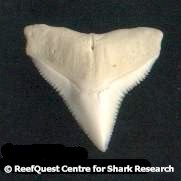 broad, flattened, serrated blade tapering
to narrow apex
broad, flattened, serrated blade tapering
to narrow apex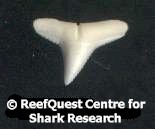 narrow, flattened, unserrated blade
narrow, flattened, unserrated blade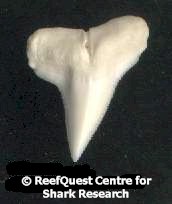 oblique, flattened blade with broad serrated shoulders tapering to
narrow apex
oblique, flattened blade with broad serrated shoulders tapering to
narrow apex